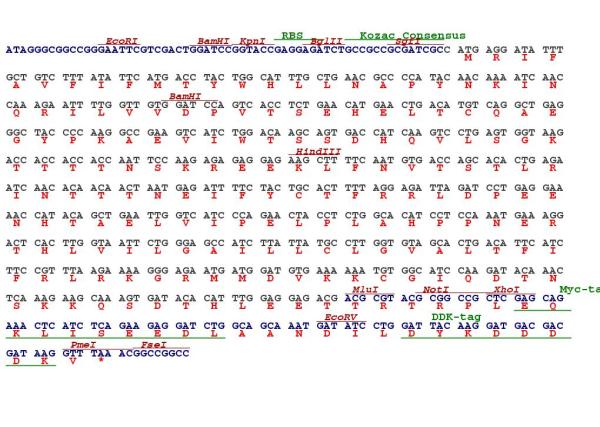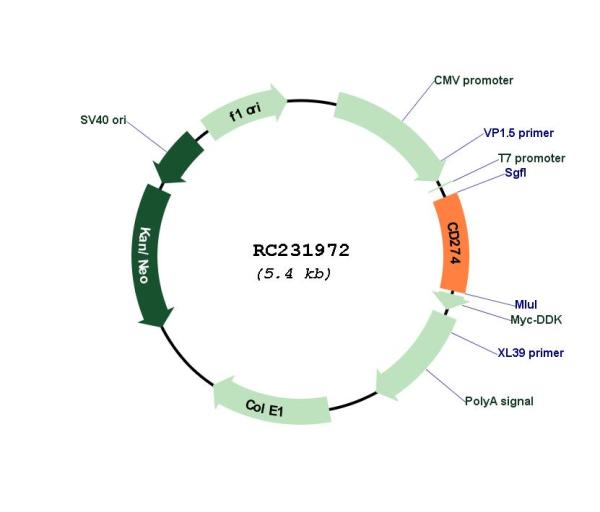PD-L1 (CD274) (NM_001267706) Human Tagged ORF Clone
SKU
RC231972
PD-L1 / CD274 (Myc-DDK tagged) - Homo sapiens PD-L1 / CD274molecule (PD-L1 / CD274), transcript variant 2
-
TrueORF®
TrueORF®
Expression-ready ORF plasmid with C-terminal tag(s)
Click here to learn more.
| Product Data | |
| Type | Human Tagged ORF Clone |
|---|---|
| Target Symbol | PD-L1 |
| Synonyms | B7-H; B7H1; hPD-L1; PD-L1; PDCD1L1; PDCD1LG1; PDL1 |
| Vector | pCMV6-Entry |
| E. coli Selection | Kanamycin (25 ug/mL) |
| Mammalian Cell Selection | Neomycin |
| Sequence Data |
ORF Nucleotide Sequence
>RC231972 representing NM_001267706
Red=Cloning site Blue=ORF Green=Tags(s) TTTTGTAATACGACTCACTATAGGGCGGCCGGGAATTCGTCGACTGGATCCGGTACCGAGGAGATCTGCC GCCGCGATCGCC ATGAGGATATTTGCTGTCTTTATATTCATGACCTACTGGCATTTGCTGAACGCCCCATACAACAAAATCA ACCAAAGAATTTTGGTTGTGGATCCAGTCACCTCTGAACATGAACTGACATGTCAGGCTGAGGGCTACCC CAAGGCCGAAGTCATCTGGACAAGCAGTGACCATCAAGTCCTGAGTGGTAAGACCACCACCACCAATTCC AAGAGAGAGGAGAAGCTTTTCAATGTGACCAGCACACTGAGAATCAACACAACAACTAATGAGATTTTCT ACTGCACTTTTAGGAGATTAGATCCTGAGGAAAACCATACAGCTGAATTGGTCATCCCAGAACTACCTCT GGCACATCCTCCAAATGAAAGGACTCACTTGGTAATTCTGGGAGCCATCTTATTATGCCTTGGTGTAGCA CTGACATTCATCTTCCGTTTAAGAAAAGGGAGAATGATGGATGTGAAAAAATGTGGCATCCAAGATACAA ACTCAAAGAAGCAAAGTGATACACATTTGGAGGAGACG ACGCGTACGCGGCCGCTCGAGCAGAAACTCATCTCAGAAGAGGATCTGGCAGCAAATGATATCCTGGATT ACAAGGATGACGACGATAAGGTTTAA
Protein Sequence
>RC231972 representing NM_001267706
Red=Cloning site Green=Tags(s) MRIFAVFIFMTYWHLLNAPYNKINQRILVVDPVTSEHELTCQAEGYPKAEVIWTSSDHQVLSGKTTTTNS KREEKLFNVTSTLRINTTTNEIFYCTFRRLDPEENHTAELVIPELPLAHPPNERTHLVILGAILLCLGVA LTFIFRLRKGRMMDVKKCGIQDTNSKKQSDTHLEET TRTRPLEQKLISEEDLAANDILDYKDDDDKV |
| Chromatograms |
Chromatograms
 Sequencher program is needed, download here |
| Restriction Sites |
SgfI-MluI Cloning Scheme for this gene
Plasmid Map

|
| ACCN | NM_001267706 |
| ORF Size | 528 bp |
| OTI Disclaimer | Due to the inherent nature of this plasmid, standard methods to replicate additional amounts of DNA in E. coli are highly likely to result in mutations and/or rearrangements. Therefore, OriGene does not guarantee the capability to replicate this plasmid DNA. Additional amounts of DNA can be purchased from OriGene with batch-specific, full-sequence verification at a reduced cost. Please contact our customer care team at custsupport@origene.com or by calling 301.340.3188 option 3 for pricing and delivery. The molecular sequence of this clone aligns with the gene accession number as a point of reference only. However, individual transcript sequences of the same gene can differ through naturally occurring variations (e.g. polymorphisms), each with its own valid existence. This clone is substantially in agreement with the reference, but a complete review of all prevailing variants is recommended prior to use. More info |
| OTI Annotation | This clone was engineered to express the complete ORF with an expression tag. Expression varies depending on the nature of the gene. |
| Components | The ORF clone is ion-exchange column purified and shipped in a 2D barcoded Matrix tube containing 10ug of transfection-ready, dried plasmid DNA (reconstitute with 100 ul of water). |
| Reconstitution Method | 1. Centrifuge at 5,000xg for 5min. 2. Carefully open the tube and add 100ul of sterile water to dissolve the DNA. 3. Close the tube and incubate for 10 minutes at room temperature. 4. Briefly vortex the tube and then do a quick spin (less than 5000xg) to concentrate the liquid at the bottom. 5. Store the suspended plasmid at -20°C. The DNA is stable for at least one year from date of shipping when stored at -20°C. |
| Note | Plasmids are not sterile. For experiments where strict sterility is required, filtration with 0.22um filter is required. |
| Shipping | Ambient |
| Reference Data | |
| RefSeq | NM_001267706.1, NP_001254635.1 |
| RefSeq Size | 3349 bp |
| RefSeq ORF | 531 bp |
| Locus ID | 29126 |
| UniProt ID | Q9NZQ7 |
| Cytogenetics | 9p24.1 |
| Protein Families | Druggable Genome, Transmembrane |
| Protein Pathways | Cell adhesion molecules (CAMs) |
| MW | 20.2 kDa |
| Summary | This gene encodes an immune inhibitory receptor ligand that is expressed by hematopoietic and non-hematopoietic cells, such as T cells and B cells and various types of tumor cells. The encoded protein is a type I transmembrane protein that has immunoglobulin V-like and C-like domains. Interaction of this ligand with its receptor inhibits T-cell activation and cytokine production. During infection or inflammation of normal tissue, this interaction is important for preventing autoimmunity by maintaining homeostasis of the immune response. In tumor microenvironments, this interaction provides an immune escape for tumor cells through cytotoxic T-cell inactivation. Expression of this gene in tumor cells is considered to be prognostic in many types of human malignancies, including colon cancer and renal cell carcinoma. Alternative splicing results in multiple transcript variants. [provided by RefSeq, Sep 2015] |
Write Your Own Review
| Product Manuals |
| FAQs |
| SDS |
Citations
*Delivery time may vary from web posted schedule. Occasional delays may occur due to unforeseen
complexities in the preparation of your product. International customers may expect an additional 1-2 weeks
in shipping.






